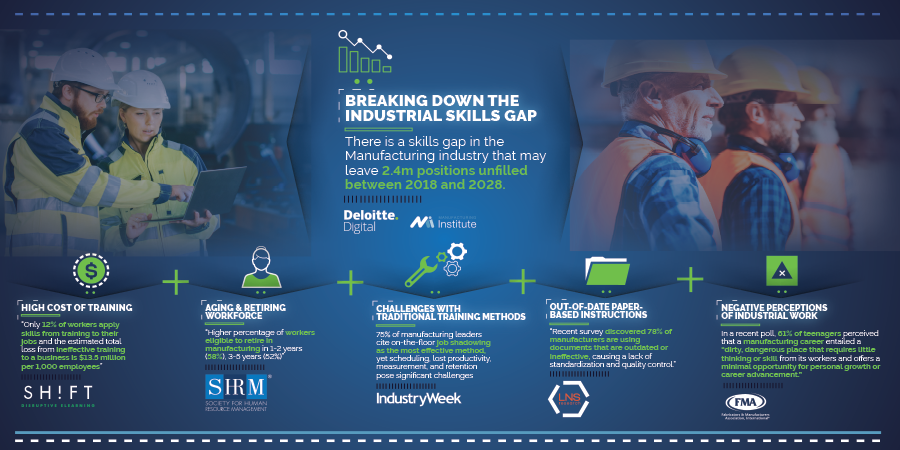
A skills gap currently faced by industrial enterprises is the result of an accumulation of several factors, not solely a worker shortage, which is a misalignment of labor supply and demand. While a worker shortage is a major influence of the manufacturing skills gap, there are various other industry influences contributing to this growth inhibiting dilemma.
For the projected 2.4 million manufacturing skills gap, the roots of the issue seed down to fundamentally rudimentary ways of training new employees; converging detrimental labor happenings with a ‘silver tsunami’ of industrial workers approaching retirement, taking years of expertise and knowledge with them; and an uninterested and under prepared younger workforce currently not a viable replacement.
Manufacturers preemptively identifying these issues and implementing innovative digital technologies like augmented reality tied to desired business outcomes can lessen the severity of the skill gap, forecasted to impact economic US output by $2.5 trillion over the next decade. These companies are also looking towards improving training to mitigate this, but current procedures are overdue for a massive overhaul.

Lessons taught through blended learning techniques, such as classroom training, often suffer from information overload and do not translate into skills developed for real-world usage. Memorizing a product manual or work procedures in an out-of-context environment will not properly prepare the trainee for real-world situations where configurations and conditions are varied.
Without consistent repetition and reinforcement of work-related concepts, workers will forget 50 percent of information within one hour, 70 percent within 24 hours, and 90 percent over a week. This makes in-context ‘on-the-job’ training the most effective form of learning, but it comes with costly challenges and bottlenecks for scheduling, interrupting operators, and trainer availability.
Annual training expenditures in the US reached nearly $90 billion in 2018 with manufacturers/distributors averaging over four million dollars in their annual budget and spending the most per learner. With a lowering investor PMI score and a constant need for manufacturers to drive operational efficiencies, this training expenditure is a major financial footprint and needs to provide increasingly high return on investment.
Baby Boomers make up 75 million US citizens and nearly half of the 160 million US labor force, will have their labor participation rate fall from 80% to under 40% by 2022. Boomers make up approximately 25% of the manufacturing workforce and the majority of industry expertise we associate with older personnel in the industry.
While there isn’t an overnight solution to accommodate for this loss of prudent knowledge of retiring workers, manufacturers are looking to alleviate the damage and cite it as a critical procedure with some even overpaying retired employees to come back to work.
Once these aging industrial workers inevitably reach retirement, the knowledge and expertise they’ve accumulated over the years on different machines, systems, operating procedures, and other aspects of work, is largely non-digitized or otherwise documented. What little is captured resides on paper documents, which can be illegible, unscalable, and unusable without context.
It’s difficult to put a metric on it, but the amount of knowledge expertise that resides in manufacturer’s human capital is immense and is why factories can run with minimal downtime and at unprecedented speeds. Not being able to capture, document, and distribute this expertise as it leaves a life at the factory for a life of leisure, is a colossal business value loss and contributor to the growing skills gap.
A recent study shows that 70% of respondents claim it costs an organization time and money to replace unique work knowledge an employee takes when they leave and 61% say organizations that don’t attempt to preserve and share unique knowledge are making a mistake.
A headache manufactures constantly hear when recruiting younger talent is that their jobs aren’t perceived as ‘cool’, yet it pays competitively when comparing to other industries. This generation is accustomed to daily digital touchpoints with desktops, laptops, or mobile devices, which can be challenging to imagine in a factory scenario for some. The lack of interest is costly, dissuading potential recruits from seeking out supplementary education like Perkins career and technical education programs (CTE) to fill open jobs. Nearly all manufacturers have a hard time finding new hires while most believe there is a significant talent shortage in U.S. manufacturing.
The manufacturing industry is turning this lack of technological knowledge and usage perception on its head, with advanced robotics, augmented reality and other innovative technologies becoming commonplace on production lines. Manufacturers proactively executing on their digital transformation initiatives will have a recruiting advantage on attracting the younger tech-savvy workforce.
Even among outsourcing headlines, manufacturing is and will continue to be one of the greatest economic drivers in the US. Solving this skill gap conundrum will be invaluable to its future prosperity and there are pieces manufacturers can put in place to do so. While the workforce will continue to turn over, we can use technologies to capture and transfer their knowledge to existing and new employees, improving training and onboarding procedures.
Similarly, manufacturers can induce better methods of training and learning through technology for personnel to better retain job principles and implement skills developed. Embracing digital transformation initiatives like replacing paper-based work instructions with updateable virtual work instructions, versus putting off digital transformation and reacting retrospectively can have a cascading affect not only on workforce productivity, but also recruiting the next crop of digitally-native talent.
The manufacturing skills gap is upon us, and those proactive through digital transformation can lessen its impact and even gain competitive advantages if implemented successfully.

David Immerman is a business analyst on PTC’s Corporate Marketing team providing thought leadership on technologies, trends, markets, and other topics. Previously David was an industry analyst in 451 Research’s Internet of Things channel primarily covering the smart transportation space and automotive technology markets, including fleet telematics, connected cars, and autonomous vehicles. He also spent time researching IoT-enabling technologies and other industry verticals including industrial. Prior to 451 Research, David conducted market research at IDC.
©Copyright 2025. All rights reserved by Modelcam Technologies Private Limited PUNE.